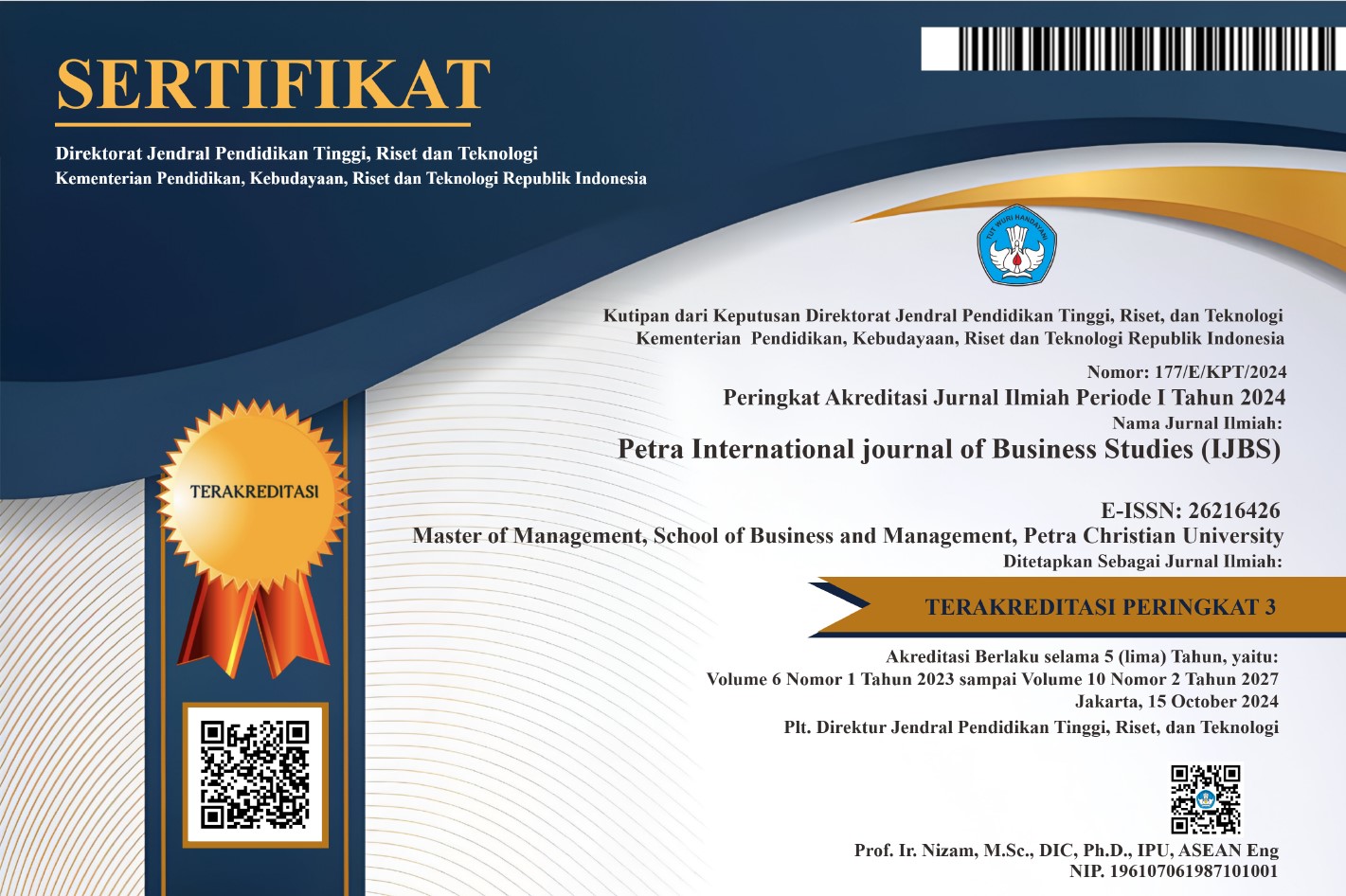Influence of IT Application to Organizational Performance mediated by warehouse management and customer relationship management
DOI:
https://doi.org/10.9744/ijbs.2.1.44-52Keywords:
IT Application., Warehouse management, customer relationship management, organizational performanceAbstract
In this thesis discuss about the affect of Information Technology Application to Organizational Performance through Warehouse Management and Customer Relationship Management on company. In this study using primary data with a population of 109 companies and 52 samples of companies using data collection methods, namely 5 points Likert scale in the form of questionnaires distributed in companies that are groups on third party logistic companies in Surabaya and Sidoarjo. This study uses Structural Equation Modeling analysis techniques, also called path modeling with SmartPLS tools. The questionnaire collected was 53 questionnaires. The result showed that the affect of Information Technology Application on Organizational Performance were positive and significant. In addition, the results also showed that the affect of Information Technology Application on Warehouse Management were positive and significant, the result showed that the affect of Information Technology Application on Customer Relationship Management were positive and significant, the result also showed that the affect of Warehouse Management on Organizational Performance were positive and significant, and the result showed that the affect of Customer Relationship Management on Organizational Performance were positif and significant in 3PL companies in Surabaya and Sidoarjo
Downloads
References
Berg, J. P. V. Den, & Zijm, W. H. M. (1999). Models for warehouse management: Classification and examples. International Journal of Production Economics. https://doi.org/10.1016/S0925-5273 (98)00114-5
Bharadwaj, A. S. (2000). A Resource-Based Perspec-tive on Information Technology Capability and Firm Performance: An Empirical Investigation. MIS Quarterly, 24(1), 169. https://doi.org/10. 2307/3250983
Chen, Y., & Zhu, J. (2004). Measuring Information Technology’ s Indirect Impact. Information Technology and Management, 5, 9–22. https://doi.org/10.1023/B:ITEM.0000008075.43543.97
Dibrell, C., Davis, P. S., & Craig, J. B. (2009). The performance implications of temporal orienta-tion and information technology in organization environment synergy. Journal of Strategy and Management, 2(2), 145–162. https://doi.org/10. 1108/17554250910965308
Faber, N., Koster, R. (Marinus) B. M. de, & Velde, S. L. Van de. (2002). Linking warehouse com-plexity to warehouse planning and control structure An exploratory study of the use of systems, 32(5), 381–395. https://doi.org/10. 1108/09600030210434161
Ghozali, I., & Latan, H. (2015). Partial least squares: Konsep, teknik dan aplikasi menggunakan program SmartPLS 3.0 untuk penelitian empiris. Semarang: Badan Penerbit UNDIP.
Gomes, C. F., Yasin, M. M., & Lisboa, J. V. (2004). A literature review of manufacturing perfor¬mance measures and measurement in an organizational context: a framework and direc¬tion for future research. Journal of Manufactur¬ing Technology Management, 15(6), 511–530. https://doi.org/10.1108/17410380410547906
Isaksson, O. H. D., & Seifert, R. W. (2014). Inventory leanness and the financial performance of firms. Production Planning and Control, 25(12), 999–1014. https://doi.org/10.1080/09537287.2013. 797123
Jayachandran, S., Sharma, S., Kaufman, P., & Raman, P. (2005). The Role of Relational Information Processes and Technology Use in Customer Relationship Management. Journal of Marketing, 69(4), 177–192. https://doi.org/ 10.1509/jmkg.2005.69.4.177
Jayaram, J., & Tan, K. C. (2010). Supply chain integration with third-party logistics providers. International Journal of Production Economics, 125(2), 262–271. https://doi.org/10.1016/j.ijpe. 2010.02.014
Josiassen, A., Assaf, A. G., & Cvelbar, L. K. (2014). CRM and the bottom line: Do all CRM dimen-sions affect firm performance? International Journal of Hospitality Management, 36, 130–136. https://doi.org/10.1016/j.ijhm.2013.08.005
Krasnikov, A., Jayachandran, S., & Kumar, V. (2009). The Impact of Customer Implemen¬tation on Cost and Profit Efficiencies : Evidence from the U . S . Commercial Banking Industry. Journal of Marketing, 73(November), 61–76. https://doi.org/10.1509/jmkg.73.6.61
Lambert, D. M., & Cooper, M. C. (2000). Issues in Supply Chain Management. Industrial Market-ing Management, 29(1), 65–83. https://doi.org/ 10.1016/S0019-8501(99)00113-3
Lwiki, T., Ojera, P. B., Mugenda, N. G., & Wachira, V. K. (2013). The Impact of Inventory Mana-gement Practices on Financial Performance of Sugar Manufacturing Firms in Kenya Timothy Lwiki Lecturer in Accounting & Finance Sigalagala National Polytechnic P. O Box 2966-50100, Kakamega Kenya Patrick Boni¬face Ojera, Phd S. International Jounal of Business, Humanities and Technology, 3(5), 75–85.
Manthou, V., & Vlachopoulou, M. (2001). Bar-code technology for inventory and marketing mana-gement systems: A model for its development and implementation. International Journal of Production Economics, 71(1–3), 157–164. https://doi.org/10.1016/S0925-5273(00)00115-8
Marasco, A. (2008). Third-party logistics: A literature review. International Journal of Production Economics, 113(1), 127–147. https://doi.org/10. 1016/j.ijpe.2007.05.017.
Novák, V., & Krajčovič, M. (2011). Warehouse Management System. In Transcom, 9th Euro-pean conference of young research and scientific workers 26-27 (pp. 23–26). Retrieved from http://www.transcom-conference.com/ uploads/archive/2011/S02_2011_Proceedings_part2.pdf#page=23.
Nyamboga, C. M., & Kemparaju, T. . (2002). Infor-mation Technology in University Libraries in Karnataka. Information Development, 18(4), 257–265. https://doi.org/10.1177/02666660232 1036650.
Payne, A., & Frow, P. (2005). A Strategic Framework for Customer. Journal of Marketing, 69, 167–176. https://doi.org/10.1509/jmkg.2005.69.4.167
Pérez López, S., & Alegre, J. (2012). Information technology competency, knowledge processes and firm performance. Industrial Management & Data Systems, 112(4), 644–662. https://doi. org/10.1108/02635571211225521.
Pokharel, S. (2005). Perception on information and communication technology perspectives in logis-tics. Journal of Enterprise Information Management, 18(2), 136–149. https://doi.org/ 10.1108/17410390510579882.
Rai, A., Patnayakuni, R., & Seth, N. (2006). Firm performance impacts of digitally enabled supply chain integration capabilities. MIS Q., 30(2), 225–246. https://doi.org/10.2307/25148729.
Rasi, R. Z. R. M., Rakiman, U. S., & Ahmad, M. F. Bin. (2015). Relationship Between Lean Production and Operational Performance in the Manufacturing Industry. IOP Conference Series: Materials Science and Engineering, 83, 012016. https://doi.org/10.1088/1757-899X/83/ 1/012016.
Seuring, S., & Müller, M. (2008). From a literature review to a conceptual framework for sus-tainable supply chain management. Journal of Cleaner Production, 16(15), 1699–1710. https://doi.org/10.1016/j.jclepro.2008.04.020.
Thomas, J. S., & Sullivan, U. Y. (2005). Managing Marketing Communications with Multichannel Customers. Journal of Marketing, 69(4), 239–251. https://doi.org/10.1509/jmkg.2005.69.4.239
Vachon, S., & Klassen, R. D. (2008). Environmental management and manufacturing performance: The role of collaboration in the supply chain. International Journal of Production Economics, 111(2), 299–315. https://doi.org/10.1016/j.ijpe. 2006.11.030.
Wang, Y., & Feng, H. (2012). Customer relationship management capabilities. Management Deci¬sion, 50(1), 115–129. https://doi.org/10.1108/ 00251741211194903.
Additional Files
Published
Issue
Section
License
Petra IJBS (e-ISSN: 2621-6426) is published by Master of Management program, School of Business and Management, Petra Christian University, Indonesia (MM SBM PCU).












